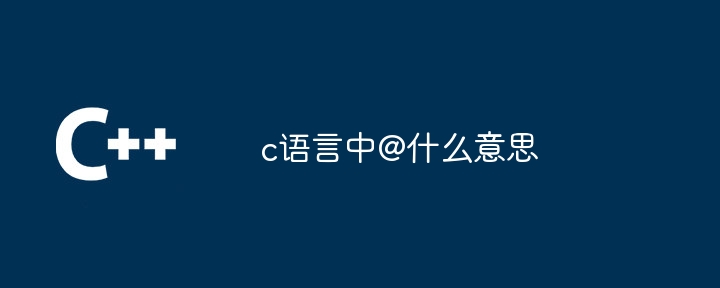What does @ mean in C language?
In C language, the @ symbol has two meanings: Macro expansion operator: replaces the macro name with its definition. Address operator: returns the address of its operand, used for the address of a pointer pointing to a variable.

The meaning of the @ symbol in C language
In C language, the @ symbol has two main meanings:
1. Macro expansion operator
When the @ symbol is used for macro expansion, it will replace the macro name with its corresponding definition. For example:
#define MAX 100 int array[MAX];
When expanding the statement int array[MAX];, the @ symbol replaces MAX with its definition 100, resulting in The following expanded statement:
int array[100];
2. Address Operator
When the @ symbol is used for address operations, it will return the address of its operand. The operand can be a variable, array element, or structure member. For example:
int x = 10; int *ptr = &x;
In this code, &x represents the address of x, and ptr points to the address. Therefore, *ptr can access the value of variable x.
The above is the detailed content of What does @ mean in C language?. For more information, please follow other related articles on the PHP Chinese website!

Hot AI Tools

Undresser.AI Undress
AI-powered app for creating realistic nude photos

AI Clothes Remover
Online AI tool for removing clothes from photos.

Undress AI Tool
Undress images for free

Clothoff.io
AI clothes remover

AI Hentai Generator
Generate AI Hentai for free.

Hot Article

Hot Tools

Notepad++7.3.1
Easy-to-use and free code editor

SublimeText3 Chinese version
Chinese version, very easy to use

Zend Studio 13.0.1
Powerful PHP integrated development environment

Dreamweaver CS6
Visual web development tools

SublimeText3 Mac version
God-level code editing software (SublimeText3)

Hot Topics
 How to handle special characters in C language
Apr 03, 2025 pm 03:18 PM
How to handle special characters in C language
Apr 03, 2025 pm 03:18 PM
In C language, special characters are processed through escape sequences, such as: \n represents line breaks. \t means tab character. Use escape sequences or character constants to represent special characters, such as char c = '\n'. Note that the backslash needs to be escaped twice. Different platforms and compilers may have different escape sequences, please consult the documentation.
 How to convert char in C language
Apr 03, 2025 pm 03:21 PM
How to convert char in C language
Apr 03, 2025 pm 03:21 PM
In C language, char type conversion can be directly converted to another type by: casting: using casting characters. Automatic type conversion: When one type of data can accommodate another type of value, the compiler automatically converts it.
 How to use char array in C language
Apr 03, 2025 pm 03:24 PM
How to use char array in C language
Apr 03, 2025 pm 03:24 PM
The char array stores character sequences in C language and is declared as char array_name[size]. The access element is passed through the subscript operator, and the element ends with the null terminator '\0', which represents the end point of the string. The C language provides a variety of string manipulation functions, such as strlen(), strcpy(), strcat() and strcmp().
 What is the role of char in C strings
Apr 03, 2025 pm 03:15 PM
What is the role of char in C strings
Apr 03, 2025 pm 03:15 PM
In C, the char type is used in strings: 1. Store a single character; 2. Use an array to represent a string and end with a null terminator; 3. Operate through a string operation function; 4. Read or output a string from the keyboard.
 How to represent characters in C language
Apr 03, 2025 pm 03:27 PM
How to represent characters in C language
Apr 03, 2025 pm 03:27 PM
The char data type represents a single character in C language and is used to store characters or ASCII code values. 1. Store character constants (such as 'a') 2. Store ASCII code value (such as 65 represents capital letter 'A')
 How to assign values to char variables in C language
Apr 03, 2025 pm 03:30 PM
How to assign values to char variables in C language
Apr 03, 2025 pm 03:30 PM
In C language, the methods of assigning values to char variables are: assigning values in single quotes, for example: char ch = 'a'; assigning values using character constants, for example: char ch = '\n'; assigning values using arithmetic, for example: char ch = 'a' 1; assigning values using pointers, for example: char ptr = "Hello"; char ch = ptr;
 Avoid errors caused by default in C switch statements
Apr 03, 2025 pm 03:45 PM
Avoid errors caused by default in C switch statements
Apr 03, 2025 pm 03:45 PM
A strategy to avoid errors caused by default in C switch statements: use enums instead of constants, limiting the value of the case statement to a valid member of the enum. Use fallthrough in the last case statement to let the program continue to execute the following code. For switch statements without fallthrough, always add a default statement for error handling or provide default behavior.
 What is the function of C language sum?
Apr 03, 2025 pm 02:21 PM
What is the function of C language sum?
Apr 03, 2025 pm 02:21 PM
There is no built-in sum function in C language, so it needs to be written by yourself. Sum can be achieved by traversing the array and accumulating elements: Loop version: Sum is calculated using for loop and array length. Pointer version: Use pointers to point to array elements, and efficient summing is achieved through self-increment pointers. Dynamically allocate array version: Dynamically allocate arrays and manage memory yourself, ensuring that allocated memory is freed to prevent memory leaks.






